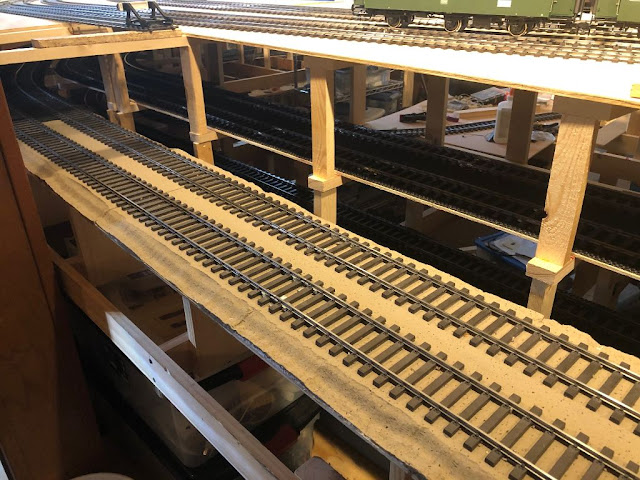My wife is an over-the-road trucker, which means she doesn't make it home more often than about every three weeks. Her visits to the basement are even more infrequent. However this past weekend she was quite interested in seeing the progress I had made on the layout. She followed me down to the basement and gasped in astonishment when she saw how much has been accomplished. I smiled broadly at her admiration. This she followed up with, "Okay, so?" "So what?" I retorted. "So let's see it run!" she demanded. This was followed by, "And why does the big steam locomotive not have any cars behind it?"
I really hadn't spent a significant amount of time running trains, and certainly there were some trains that had been prone to uncoupling and other maladies, including the afore-mentioned 'big steam locomotive', my KM-1 BR50. There were plenty of trains on the layout, but mostly for show, and for making the blog entries look like <ahem> everything was running fine. Well, this was going to be the test.
At some point she left and went back upstairs. Me? I was too busy managing the throttles of the Intellibox to notice her departure. She had opened Pandora's box. In no time I had four trains running around the layout simultaneously. Thankfully the trains stayed on the track and remained coupled. I kept gasping in horror as several times two trains appeared to be ready to collide. But the truth was, there were no collisions, not even close. In fact, even with four trains running simultaneously there is enough distance between them thanks to the long main line that, not only did I not have to constantly adjust throttles, but the layout itself didn't seem overloaded. Until I get used to operating the layout my mind will continue to assume that the small layout space means trains are close to colliding. But the truth is, the main line would be over 150 feet long if it were laid out straight. That's a train roughly every forty feet.
Running trains has become a daily occurrence, and I find it to be an amazing stress reliever. Here are a couple of pictures from today's operating session:
The BR50 is pulling a coal train (well, a string of empties until I create coal inserts) while the V200 and it's FD-Zug wait for the signal to turn green. The BR50 is headed from the parade section down into the bottom staging yard, while the FD-Zug is going to be entering the station above it as soon as the signal changes to Hp1.The signal turns green for the FD-Zug 'Gambrinus' just as the last coal car passes the block signal. The Big diesels in the V200 are roaring to life and the locomotive is about to move...














































